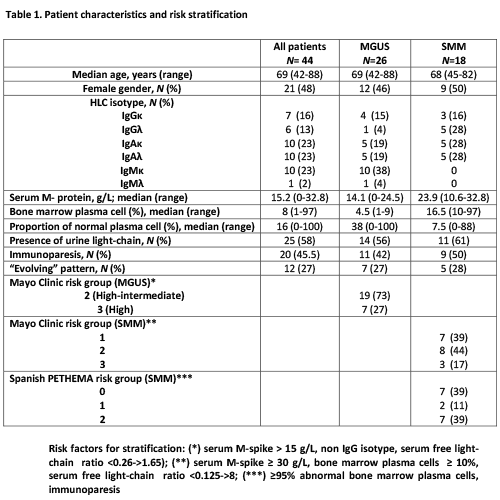Abstract: PB1952
Type: Publication Only
Background
Monoclonal gammopathy of undetermined significance (MGUS) and smoldering multiple myeloma (SMM) are conditions that usually precede symptomatic multiple myeloma (MM). Risk stratification is crucial, considering the heterogeneous progression rate among these patients and the chemoprevention trials encouraged for high risk individuals. A number of prognostic factors for progression have been identified. In this sense, the novel Hevylite assay now enables us to accurately measure each isotype-specific heavy and light chain (HLC). Recently, isotype-specific uninvolved HLC pair suppression was described as an independent predictor of progression to MM in patients with MGUS. The role of Hevylite as a prognostic factor in SMM is less investigated.
Aims
The aim of the present study was to analyze the impact of HLC pairs in a series of patients with high risk MGUS and SMM and their relationship with other previously described risk factors.
Methods
Forty-four patients diagnosed with high risk MGUS or SMM at a single institution from March 2014 through April 2016 were prospectively included in the present study. Patients were stratified according to the Mayo Clinic and the Spanish PETHEMA group models. Samples at diagnosis were tested for HLC concentrations for the three pairs (IgG, IgM and IgA) by immunonephelometry.
Results
The clinical characteristics and risk stratification of patients are summarized in Table 1.
An abnormal HLC-pair ratio was detected in 96% of MGUS and 94% of SMM patients, with no differences depending on the heavy chain isotype. A highly abnormal HLC ratio (<0.02 or >45) was present in 9 patients (1 with MGUS and 8 with SMM).
HLC-pair suppression (i.e., IgG-κ in patients with IgG-λ gammopathy) was more frequent in patients with SMM (83% vs. 46%, p=0.02). Severe HLC-pair suppression (>50% below lower level of normal) was present in 12 (27%) patients, the majority of which had a diagnosis of SMM (83%). Severe HLC-pair suppression was significantly associated with a highly abnormal (<0.125 or >8) serum free light chain (FLC) ratio (p=0.004), abnormal/normal bone marrow plasma cell ratio >0.95 (p<0.001) and immunoparesis (p=0.005), being present in 6 (86%) of the 7 patients with high risk SMM.
Suppression of the other isotypes (i.e., IgA or IgM HLC pairs in a patient with IgG gammopathy) was identified in 33 (75%) patients, namely in 18 (69%) patients with MGUS and 15 (83%) patients with SMM (p=0.48), and was not significantly associated with other risk factors for progression. Severe suppression (>50% below lower level of normal) was significantly more frequent in SMM patients (33% vs. 8%, p=0.04) and was associated with highly abnormal FLC ratio (p=0.001), abnormal/normal plasma cell ratio >0.95 (p<0.001), severe HLC-pair suppression (p<0.001) and highly abnormal HLC ratio at diagnosis (p=0.005).
The “evolving” pattern of the serum M-protein was identified in 12 patients (MGUS 7, SMM 5) and it was not significantly associated with either severe suppression of the HLC-pair or of the other isotypes.
After a median follow-up of 18 months (range, 6-35) progression to symptomatic MM was observed in 3 patients. All 3 had a diagnosis of SMM with an “evolving” pattern, highly abnormal HLC-ratio and severe HLC-pair suppression.

Conclusion
The findings presented in this study indicate that highly abnormal HLC ratio, severe suppression of the HLC-matched pair and other isotype HLC pairs are associated with known risk factors for disease progression in patients with high risk MGUS and SMM. The HLC assay could become a valuable tool in the risk stratification of these patients.
Session topic: 14. Myeloma and other monoclonal gammopathies - Clinical





